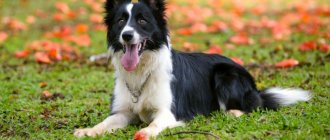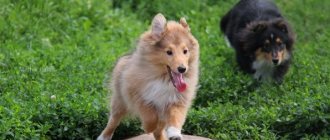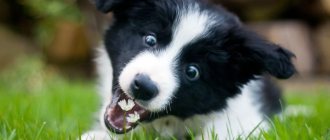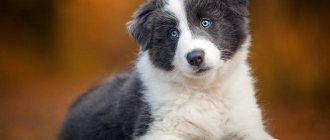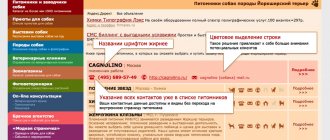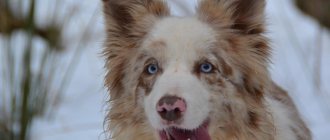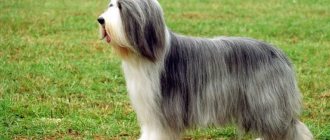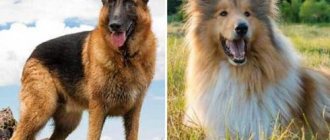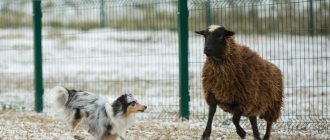The Scottish Sheepdog, originating from the British Isles, is an ancient breed whose original purpose was to herd domestic animals.
In the 19th century, a breed began to emerge as a separate branch - the smooth collie.
The name arose as a result of the peculiarity of short hair among representatives of the breed.
While ordinary collies have a luxurious coat with long hair.
The history of the formation of the breed has not yet been completed, but many people have already come to love the dog as a devoted and faithful friend.
History of the breed
The homeland of the collie is considered to be Great Britain, more precisely the mountainous regions of Scotland.
There are several theories regarding the origin of the collie. The most common of them says that the ancestors of herding shepherd dogs were squat animals with hard short black hair, which came to the British Isles along with the Roman conquerors.
Some experts dispute the origin of collies from ancient Roman dogs and argue that at that time England already had its own shepherd dogs.
On average, the age of the breed is estimated at two to three thousand years. The main purpose of the collie was to protect sheep from predators, which the dogs did very well.
Short-haired representatives of the breed appeared in the middle of the 19th century. as a result of crossing old-type black collies and English greyhounds - greyhounds.
There is also no consensus on the name of the breed. According to one version, the dogs were named by analogy with the black-headed Scottish sheep - colley, which shepherds herded since ancient times. According to the second, the name comes from the old English word coaly, which means “black”.
Queen Victoria of England made a significant contribution to the development of the breed. Having visited Scotland, the royal lady noticed dogs with an impressive appearance and remarkable ingenuity. The ruler brought several individuals to England. Since then, herding dogs have become widespread as companion dogs.
The collie was first presented at an exhibition in London in 1860 as a universal Scottish sheepdog, and in 1870 the dogs were divided into long-haired and short-haired. In 1974, a modern breed standard was approved, which officially established two types of Scottish Shepherds. Since 1993, matings between smooth and long-haired collies have been put an end to, and the English Kennel Club no longer registers mixed litters.
In America and Australia, collies with different coat lengths are still considered one breed, and matings between them are allowed by the American Kennel Club.
Short-haired shepherd dogs appeared in Russia in 1993. The pets were brought from Estonia and became the founders of the Russian “smooth” breed. Thanks to competent selection, Russian collies with short hair are worthy competition to their foreign counterparts.
Generally recognized breed standards
FCI Standard No. 296 dated 10/19/1988. Translation by RKF.
Breed classification:
- country of origin: UK;
- Application: companion dog;
- general impression: an intelligent, alert dog of medium size, harmonious build with an elongated head and pointed muzzle;
- Behavior/temperament: cheerful, friendly, never nervous or aggressive;
- FCI classification: group 1: herding and cattle dogs;
- section 3: shepherd dogs (herding dogs);
- no operational tests.
- FCI,
- males: 56–61 cm;
- males: 20.5 – 29.5 kg;
Table: external features of the breed
| Options | Description |
| Head | When viewed from the front or side, it resembles a blunt, clean wedge with smooth outlines. The point in the middle between the inner corners of the eyes is the center of balance of the head along the length |
| Scull | Flat. The lateral lines gradually taper from the ears to the tip of the nose. The depth of the skull from the eyebrows to the lower jaw is not deep |
| Stop | Lightweight but noticeable. The center of a correctly positioned stop transition is the midpoint between the inner corners of the eyes |
| Nose | The lobe is large, always black |
| Muzzle | Long, but not pointed, the ending is rounded and blunt. The length of the muzzle is equal to the length of the skull |
| Jaws/teeth | Correct scissor bite. The lower jaw is strong, clearly outlined by black lips. Jaws strong, strong |
| Eyes | Medium size, almond-shaped, dark brown (in the blue merle color there are blue eyes or with blue splashes). Lively, intelligent and vigilant look |
| Ears | Small, widely spaced, semi-erect type |
| Neck | Muscular, strong, appropriate length, well arched |
| Frame | Slightly longer than the height at the withers, the back is horizontal, strong, with a soft rise in the lower back, well sprung ribs, deep chest, rather wide at the shoulders |
| Tail | Long, the end of the last vertebra reaches the hock joint. When at rest it is lowered, the end is slightly bent upward |
| Forelegs | The shoulders are sloping, with well-defined angles. The forelegs are strong and muscular, with elbows turned neither out nor in, and moderately bony. The forearms are very muscular, the pasterns are flexible, but not weak. |
| Hind limbs | Hind legs with muscular thighs, dry and sinewy below, with good knee bend. Metatarsus low, strong |
| Paws | Oval soles with good pads. The fingers are curved and closed together. The hind legs are slightly less curved |
| Wool | Short, close-fitting, the guard hair is hard, with a very dense undercoat. Cannot be trimmed or trimmed |
| Color | Three colors are recognized:
|
| Movements | Powerful and energetic. When viewed from the side, the movements are smooth. A moderately long stride is desirable. It should be done easily, without effort |
| Violations of the standard for which points are deducted | Any deviation from the above points should be considered as a defect, the assessment of which should be in strict accordance with the degree of this deviation |
| Disqualifying Faults |
Note: Males must have two apparently normal testes fully descended into the scrotum |
Gallery: Shorthaired Collie colors
Blue Merle Color: Predominantly clear, silvery blue, flecked with black spots like merle
Tri-color: predominantly black with red markings on the legs and head
Sable color ranges from light gold to rich mahogany
Australian Shepherd (Aussie)
This breed was developed in the USA in the 20th century. The name “Australian” appeared because it was from Australia that the ancestors of the Aussie, the Scottish border collies, were brought. In the states, they were crossed with some other breeds, including naturally - through free crossing between neighboring dogs.
| Aussies have an open and very friendly character. Photo: Bonnie van den Born, wikimedia. |
Aussies have an open and very friendly character, making them an ideal human companion. This hardworking dog is happy in an alliance with a person when it can be useful. If there are no walks or useful functions, the dog will begin to get bored and its appetite will spoil.
The Australian Shepherd is great with children, has a high level of intelligence and perfectly understands the situation in the family and senses the emotional state. Thanks to this, she literally guesses the wishes of the owners, and also skillfully discharges the tension that appears from time to time in any family.
Training and raising an Australian Shepherd is easy. They learn even complex commands. If an Aussie dog is a companion to a person with disabilities, then it may well learn to follow commands that will make life easier for its owner.
Aussies have a large body (46-51 cm) with long hair. The muzzle is elongated, the head is oval. The chest is rounded and voluminous, the legs are shorter than average, the body is strong and muscular. The tail is long and fluffy.
Character of the breed
The character of the short-haired collie can without hesitation be attributed to the strengths of this breed. The main advantage of animals is their extraordinary intelligence. During training, pets can understand many words, remember commands the first time and easily learn new tricks. Even an inexperienced owner can properly raise smooth collies.
Representatives of this breed are phenomenally sensitive, they capture the emotional state of the owner and adapt to it. Dogs crave human companionship, constantly need attention, and suffer terribly when alone. Changing owners is a difficult experience for collies. They get used to a new family for a long time and with great care.
“Smooth” ones single out one owner, but treat all family members with great respect and love. Short-haired collies will be ideal pets for a large family with many children. Dogs not only become attached to their owner’s children, but love them with almost maternal love, receiving true pleasure from communicating with them. For kids, pets become caring nannies and vigilant guards.
The smooth collie becomes a caring nanny and a vigilant guard for the owner's child.
The sociability and friendliness of herding dogs has no boundaries. They have excellent relationships with other dogs and all animals living in the same territory with them.
Long-haired collies are wary of strangers, but they never attack without reason. If the person is friendly, the dogs will remain calm.
Smooth collies are more emotional and temperamental than their long-haired relatives. Animals try to convey all their emotional impulses with their voices, and the range of their sounds is quite diverse. To make less noise from dogs, you need to stop causeless barking from childhood.
Photo gallery
We invite you to take another look at the graceful representatives of this variety of collie. Thanks to their friendly disposition and fairly easy maintenance, these dogs are perfect as a pet for almost everyone.
Care and maintenance of the smooth collie
The ideal place to keep a smooth collie is a large country house with a fenced surrounding area. The dog will also feel quite comfortable in the apartment, provided it takes daily walks with active physical activity.
The collie's sleeping place should not be too hard, because when lying on a hard surface, the dog will develop calluses on the elbows, which can fester and hurt.
Under no circumstances should animals be housed in a booth or locked in an enclosure, as psychologically they will suffer greatly when alone and need constant communication with the owner.
Table: Grooming Procedures for Smooth Collie
| Procedure | Frequency of execution | Recommendations |
| Bathing | As needed, but not more than once a month | For bathing, it is recommended to purchase special cosmetics for dogs. Shampoos containing alkali may cause skin irritation |
| Combing | 1–2 times a week | Wool does not require special care. It is enough to comb the dog once a week with a special metal comb. During the molting period, you need to comb the animal daily. If necessary, flea and tick treatment should be carried out promptly. |
| Eye care | Every day | The eyes must be examined daily for inflammation and cleared of tear tracks. Natural discharge should be removed with a cotton pad soaked in miramistin solution or chamomile decoction |
| Ear cleaning | Weekly | Once a week, the pet needs to inspect the auricle and remove wax deposits with ear sticks. For cleaning, you need to use special ear lotions or chlorhexidine solution. |
| Oral care | Your collie's teeth and gums need to be carefully looked after: inspected and cleaned regularly. Twice a week, your pet needs to brush its teeth with a special paste and visit the veterinary clinic every six months for sanitation. To prevent plaque, you can give your dog special chewing sticks, bones or biscuits. | |
| Nail trimming | As it grows | If the dog moves a lot, it is not necessary to trim its nails, as they wear out on their own. Otherwise, it is necessary to trim the claws at least once a month with a special nail clipper. Pets accustomed to this procedure from childhood easily tolerate it. You can trim your nails yourself or contact a veterinarian or groomer. |
Power Requirements
Smooth collies are prone to overeating, so they simply need a balanced and proper diet. Each owner selects the diet for his dog independently, based on the general physiological condition, the age of the pet and the advice of a veterinarian. This can be natural food or balanced industrial feed.
You can feed your collie according to one of two schemes: ready-made dry and wet food or home-cooked food.
When creating a menu for your pet, you should adhere to some rules:
- Do not mix dry food and natural food in one meal;
- change the brand of food only when necessary, as this leads to indigestion;
- maintain the correct proportions of the daily feed intake;
- fresh water should always be freely available;
- During the period of active growth, puppies are recommended to add to their diet: vitamins to strengthen joints;
- fish fat;
- seaweed;
- charcoal.
Table: recommendations for feeding natural food
| Dog age (months) | Number of meals | Recommended products for consumption | Exceptions from the diet |
| 1,5–3 | 5–6 |
|
|
| 3–6 | 4 | ||
| 6–12 | 2 |
When feeding smooth collies with industrial food, you should give preference to premium products and focus on the line for energetic breeds.
Walk
Smooth collies are very active and energetic animals, so they require an active lifestyle, daily walks, physical and intellectual exercise. The pet will clearly miss short walks “to relieve itself.”
Collies cannot live without intense physical activity, so their walking requires spacious areas where the pet can frolic without a leash.
You need to walk your dog at least two to three times a day, and one walk should be long. It is best to let the dog run for 1 hour. This will allow her to get rid of pent-up energy, and she will not be mischievous in the house.
Training and education
Collies are easy to train, and therefore even an inexperienced amateur can teach a puppy basic commands. You need to start classes with your baby at the age of 2-3 months. It is important not to miss this period, otherwise the pet may grow up timid and withdrawn. To socialize your puppy, you need to regularly take him to the dog park so that he can interact with other animals and people.
Training will produce positive results if the relationship between the pet and the owner is built on equality and the use of motivational methods.
Even an inexperienced dog breeder will enjoy training a collie at home.
During training, the following rules should be considered:
- You shouldn’t force an animal to learn a command in one day;
- the dog should experience positive emotions from communicating with the owner and following commands;
- during the training process you need to take short breaks, otherwise the animal’s concentration will begin to sharply decrease;
- Under no circumstances should you provoke a dog to display aggression towards other people or animals;
- After following the command, the dog should be rewarded with words and treats. Gradually, the dose of “praise” should be reduced;
- Do not raise your voice or use physical punishment.
By following these tips, it is not difficult to raise an obedient pet and a vigilant bodyguard from a short-haired collie.
Having mastered the basic commands, the dog is ready for a more complex training course. “Smooth” dogs perform well in agility and various dog competitions.
A high level of training allows short-haired collies to participate in rescue operations and also serve as attentive guide dogs.
What to feed?
For dogs of this breed, it is recommended to choose a menu based on industrially produced food. Products must be at least premium class, recommended for active four-legged pets. Drinking regime is also important for the animal, so the collie should always have free access to water.
Breeders do not recommend feeding dogs natural food, since it will be quite difficult to choose a balanced diet for your pet. Treats from the human table are prohibited, as are bones and fatty meats. Shorthaired collie puppies need to be fed 4 to 5 times a day. An adult dog should be fed two meals a day - morning and evening.
Diseases and their prevention
Despite their excellent health, shorthairs are predisposed to certain diseases.
Table: diseases and their prevention
| Disease | Description of the disease | Treatment |
| Hip dysplasia | An incurable disease that can lead to partial or complete destruction of a dog's joints | For dysplasia in dogs, treatment with medications includes prescribing medications to regenerate joints and reduce pain. |
| Collie eye syndrome | A hereditary disease that is characterized by a disorder in the development of a dog's eyes | Collie eye anomaly has no cure. The only measure to prevent and control this dangerous disease is early examination of puppies (at 8–10 weeks of age) and certification of adult dogs (after 12 months) under the program for hereditary eye diseases |
| Entropion (inversion of the eyelid) | A pathological condition that is accompanied by inversion of the eyelid | The algorithm for providing care for entropion includes surgical treatment, reducing the manifestations of the disease with the help of painkillers and moisturizing medications |
| Distichiasis (extra eyelashes) | A pathology in which the smallest eyelashes grow either on the inside of the outer edge of the eyelids, or outside, but critically close to the surface of the eyeball | In animals with obvious symptoms, treatment is most often performed surgically, that is, part of the mucous membrane is removed and the hair follicle is removed. |
| Epilepsy | A nervous system disorder accompanied by sudden attacks of tremors or seizures | Epilepsy cannot be cured forever, but with the help of special medications it is possible to minimize the risk of developing seizures |
| Ectopic ureters | A congenital, often hereditary, disease in which the flow of urine into the bladder is impaired | It can only be removed surgically. The purpose of the operation is to restore the normal course of the ureter, returning it to the correct anatomical position |
| Congenital deafness | Age-related, indolent pathology, accompanied by damage to the spinal cord. In an advanced clinical picture, the dog loses control of the hind limbs partially or completely. More often, blue-eyed individuals with marbled colors suffer from the pathology. | Congenital deafness cannot be cured. Sometimes customized hearing aids may be used |
| Allergy | An abnormally increased reaction of the body to some foreign substance that has entered it by any means | The appropriate medicine can relieve itching and other symptoms for a short period of time, but for effective treatment it is necessary to correct feeding |
| Volvulus | The dog's stomach expands from gases, and then twists, affecting other organs. This already leads to disruption of blood supply throughout the body and death. | When there is a volvulus, the owner cannot help his pet with practically anything - his main function is to move the dog to the veterinary clinic |
Many representatives of the breed are sensitive to medications. Before giving your pet any medication, it is strongly recommended that you consult with your doctor.
Temperament
This breed is intelligent, responsive and devoted to its owner and work. Border Collies are extremely sensitive and thrive on human relationships. They are not recommended for beginners, sedentary or apathetic owners. They are generally good with children and other dogs, but there should be no cats or other small pets in the home.
Selection of puppies and their price
Dogs of any breed can be conditionally classified into three main groups according to their exterior and breeding qualities:
- show class - the best puppies from the litter that have great show prospects;
- breeding class - dogs with good hereditary qualities, but not without shortcomings;
- pet class - pets that have no breeding value.
These factors help determine the class of the dog, and, accordingly, its cost.
During puppyhood, it is very difficult to determine the future prospects of an animal. To increase the chances of an adequate assessment of the puppy, experienced dog experts advise buying grown-up puppies over 4 months of age.
Smooth collie puppies are distinguished by their innate intelligence and hyperactive temperament, so their leisure time should be occupied with interactive toys
Next, you can decide on the gender. This is a matter of purely personal preference, but males and females have differences in appearance and behavior that are worth keeping in mind. Males, as a rule, are distinguished by independence, and females - by complaisance. But a lot depends on the temperament of a particular dog.
Smooth Collie puppies are similar to some other breeds. To purchase a purebred dog, rather than a mixed breed or mongrel, it is best to contact professional breeders.
All large nurseries specializing in collie breeding have their own websites where you can find out all the necessary information. You can also send a request to a foreign monobreed nursery.
A puppy bought secondhand may not meet the breed standard as it grows. In addition, there is a risk of buying a sick animal, which will have to be treated for a long time and unsuccessfully.
To choose a healthy puppy, you need to consider the following nuances:
- sanitary condition of the enclosure (the room should be clean and spacious, without heavy odor);
- age of the puppy (the puppy can be separated from its mother no earlier than 2.5–3 months);
- the breeder's desire to truthfully answer questions, give advice and offer assistance to potential dog owners;
- The breeder has: a veterinary passport with all marks.
List of indicators that characterize the excellent condition of puppies at the time of selection:
- appropriate for your age;
- no signs of rickets;
- good physical form;
- compliance of color with standard standards;
- smooth, scratch-free skin;
- clean eyes, free of discharge and infectious diseases;
- ears without rash, wax and unpleasant odor;
- moist and freely breathing nose;
- straight, without bends or dislocations of the limbs;
- square body;
- straight limbs;
- stable mental state of puppies.
Even when choosing a puppy for your home, you need to rely on the above recommendations.
You should purchase an animal only if the potential owner has firm confidence that he is ready to give the dog love, affection and the necessary care.
Price of puppies
The lower price limit for smooth collie puppies is up to 15,000 rubles. For the most part, these are dogs without a pedigree, purchased through a bulletin board or at a poultry market.
Babies bought from nurseries are much more valuable and cost at least 18,000–25,000 rubles. Individual promising puppies from elite producers cost from 40,000 rubles. and higher.

